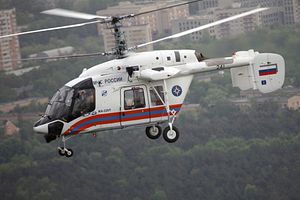While Indian Prime Minister Narendra Modi and Russian President Vladimir Putin have signed a government-to-government deal for the procurement of 200 Kamov-226T last December, New Delhi and Moscow have difficulties in meeting the contracts’s so-called “Make in India” obligation, which requires that 50 percent of the helicopter to be built in India, according to Indian media reports.
One of the major problems appears to be that Moscow has only accepted to indigenize Russian components of the light multirole helicopter, assembled by Russia’s sole rotorcraft designer Russian Helicopters. However, for example, the helicopters twin Arrius 2G1 engines –which, according to The Business Standard, constitute one third of the aircraft’s costs–are made by French helicopter maker Turbomeca. Various other component parts of the Kamov-226T have also been imported by Russian Helicopters from abroad, all of which would not fall under indigenization requirements outlined in the contract.
The burden has now fallen on India’s state-owned Hindustan Aeronautics Limited and other Indian manufacturers to negotiate with third-party vendors to build individual hardware for the Kamov-226T in India. “We will have to work with third-country suppliers and co-co-opt them into the indigenization effort to meet the ‘Make in India’ goals,” according to sources within HAL HAL and Russian Helicopters agreed in late December 2015 to form a joint venture, in which the former will have a 50.5 percent stake and the latter a 49.5 percent share.
An additional obstacle in meeting the “Make in India” requirement is that the contract allows Russian Helicopters to deliver the first 60 helicopters in flyaway condition, while the next batch of 40 Kamov-226Ts will be shipped as kits to India, where they would be assembled. Consequently, that leaves a mere 100 aircraft for meeting the 50 percent “Make in India” requirement for the entire new fleet of 200 helicopters as outlined in the intergovernmental agreement. (The helicopters are supposed to be built at a new HAL facility to be constructed in the city of Tumakuru in southern Indian.)
“The agreement on manufacturing the Kamov 226T helicopter is the first big project under the ‘Make in India’ initiative,” noted Prime Minister Narendra Modi in a joint press conference in December 2015 with President Vladimir Putin. The agreement stipulates a nine-year time frame for the delivery of the first 200 helicopters, with an option for an additional 200 aircraft. The Indian military primarily wants to deploy the 226T helicopter in reconnaissance and surveillance missions.
Overall, the Indian military plans to procure 600 new light helicopters. However, Russian helicopters will be facing competition from HAL’s new Light Utility Helicopter (LUH), which will make its first flight in February 2016, and of which the Indian defense ministry plans to acquire a fleet of 200 aircraft. According to sources interviewed by The Business Standard, “the bulk of the order for the remaining 200 would fall to whichever manufacturer delivers 200 helicopters first.”
Indo-Russian defense cooperation has proven increasingly more difficult over the last few years. As I reported previously (See: “Is Another Indo-Russian Defense Deal About to Falter”), a joint Indo-Russian project to develop a new medium-airlift military transport aircraft, the UAC/HAL II-214 Multi-role Transport Aircraft (MTA), has been “almost shelved,” according to Indian defense officials.
Furthermore, during the annual India-Russia summit, Indian Prime Minister Narendra Modi and Russian President Vladimir Putin also failed to resolve an ongoing disagreement between the two countries over the future of a joint fifth generation fighter program (See: “India and Russia Fail to Resolve Dispute Over Fifth Generation Fighter Jet”).
































